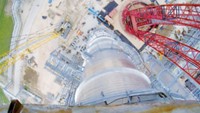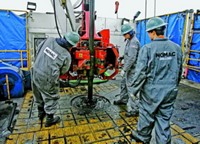Advertisement
Grab your lab coat. Let's get started
Welcome!
Welcome!
Create an account below to get 6 C&EN articles per month, receive newsletters and more - all free.
It seems this is your first time logging in online. Please enter the following information to continue.
As an ACS member you automatically get access to this site. All we need is few more details to create your reading experience.
Not you? Sign in with a different account.
Not you? Sign in with a different account.
ERROR 1
ERROR 1
ERROR 2
ERROR 2
ERROR 2
ERROR 2
ERROR 2
Password and Confirm password must match.
If you have an ACS member number, please enter it here so we can link this account to your membership. (optional)
ERROR 2
ACS values your privacy. By submitting your information, you are gaining access to C&EN and subscribing to our weekly newsletter. We use the information you provide to make your reading experience better, and we will never sell your data to third party members.
Petrochemicals
The petrochemicals party shows no signs of stopping
The industry is enjoying some good times, and they might even get better
by Alexander H. Tullo
April 16, 2018
| A version of this story appeared in
Volume 96, Issue 16

The chemical industry is booming, and little in the forecast indicates that the good times will let up anytime soon. That was the key message from the consultants and executives who presented at the IHS Markit World Petrochemical Conference 2018 in Houston last month.
Chemical makers are wrapping up tens of billions of dollars of investment in new petrochemical facilities meant to take advantage of cheap feedstocks derived from shale. Normally, such a swell in supply pours cold water on prices and hits the industry’s bottom line. But this time around, the thinking goes, demand is so strong that the world will devour every kilogram of product that firms can crank out.
Dave Witte, who heads energy and chemicals consulting at IHS Markit, began his presentation by noting that the chemical industry has enjoyed five years of strong profits and that it was natural for the 1,300 attendees to wonder when the prosperity might end. Historically, he pointed out, long periods of capacity buildup often coincide with economic weakness that compounds oversupply and results in painful industry downturns.
For example, a lot of capacity opened in 1990, just before the recession that cost George H. W. Bush the 1992 election. An industry peak in the mid-1990s was scuttled by the 1997 Asian currency crisis and the 2001 economic downturn, leading to a five-year trough for chemicals.
This time may be different. “The industry is now seeing a relatively long period of stable, though generally subdued, demand growth,” Witte said. Although a big slug of U.S. capacity for chemicals such as ethylene and polyethylene is coming onstream over the next couple of years, expansion in the Middle East and China is muted, he pointed out.
Witte expects two more very strong years for chemicals, a “slight pullback” in 2020 as the market absorbs the new output, and a resumption of strong profitability thereafter.
Mark Eramo, vice president of global chemical business development at IHS Markit, was even more optimistic. He raised the specter of a “supercycle”—an extended period of little spare capacity and robust demand when profits fatten to enormous proportions. The chemical industry hasn’t seen such a scenario in a generation.
“In each element of the value chain, we are talking about strength,” Eramo said. “Consumers are pulling hard, the assets are running hard, the feedstock is there, and the investment is occurring.”
Over the next five years, combined worldwide capacity for the base chemicals ethylene, propylene, methanol, chlorine, benzene, and p-xylene will expand by 25% to 610 million metric tons, Eramo said.
And demand should keep pace. IHS expects years of relatively low oil prices that will stimulate strong demand for chemical products. Eramo predicted that over the next five years, demand for the industry’s most basic building blocks, ethylene and propylene, will grow faster than it did over the previous five years. Operating rates for ethylene should remain above a very healthy 90%.
Sudden events such as a supply outage or a surge in demand could trigger price escalation and “record-setting profitability,” he said.
Advertisement
It’s more than just low oil prices that are buoying the industry. In his remarks at the conference, IHS Markit Chief Economist Nariman Behravesh painted a picture of a world economy that is galloping along.
In the U.S., consumer confidence is at a 17-year high. Unemployment stands at 4.1% and may dip to 3.5% next year, which would be its lowest level since the Korean War.
Globally, emerging economies such as Brazil are climbing out of recession. Europe and Japan are growing faster than they usually do.
But Behravesh sees a couple of factors that could ruin everything. One is a trade war instigated by the Trump administration’s protectionist policies. “Trade wars are bad, and they’re unwinnable,” he said.
Another is inflation, a side effect of an overheating economy. The Federal Reserve has already been inching up interest rates as a preventive measure. Behravesh said the Reserve could cause a recession if it panics and jacks rates up too fast. “Recoveries don’t die of old age,” he said. “They get killed off.”
The chemical executives who spoke at the conference, remembering the scars they’ve received over the years, opined a little cynically about all the talk of industry invincibility.
“I know that one of these days, IHS is going to have a conference about how to climb out of the deep downturn,” said Mark Lashier, CEO of Chevron Phillips Chemical. “We’ve all been around long enough to know this won’t go on forever.”
Lashier worries that strong demand and low feedstock costs won’t be enough to keep investment coming in the U.S. chemical industry. “We believe the key issue to address is rising capital costs,” he said.
In 2011, Chevron Phillips was the first chemical company in more than a decade to announce a new U.S. ethylene cracker. Since that time, Lashier has seen construction costs increase. For example, after the rush to hire construction workers, inexperienced laborers stymied productivity for a while at the company’s ethylene project.
Chevron Phillips is now evaluating building another cracker on the Gulf Coast. “But we have to be convinced that we can mitigate these risks,” Lashier said.
Doug May, president of olefins, aromatics, and alternative feedstocks at Dow Chemical, agrees. Like Chevron Phillips, Dow built an ethylene cracker on the Gulf Coast and is now planning additional expansions.
May said capital costs on the Gulf have risen by 40% over the past five years as the chemical industry was installing a lot of capacity. This rise, he said, “made many of the projects on an economic basis look very different from what was first predicted.”
Peter Huntsman, CEO of Huntsman Corp., acknowledged that industry fundamentals point to a period of prolonged profitability, but he also had a warning for attendees.
“The most feared time in the chemical industry is the very time when people say ‘we’ve learned our lessons, we’re not peaking, we’re not in the valley, we’re in a plateau, and that plateau is going to last forever,’ ” he said. “Nothing goes right in this industry for all that long.”
Huntsman told attendees to avoid getting complacent during the good times. He said his company’s polyurethanes business goes toe-to-toe with large competitors like Covestro and BASF, but it also competes with nimble young firms that formulate polyurethanes. Large chemical companies need to be flexible enough to make decisions quickly.
“Now is the time to prepare for when times ain’t so good,” he said.





Join the conversation
Contact the reporter
Submit a Letter to the Editor for publication
Engage with us on Twitter